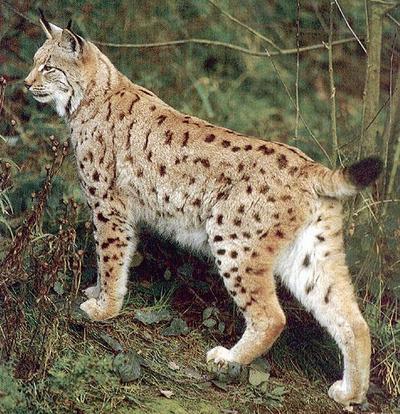
The bobcat (Lynx rufus), alias wildcat, is a medium-sized member of the North American cat family. It can be distinguished at a distance by its graceful catlike movements, short (4- to 6-inches [10- to 15-cm]) bobbed tail, and round face and pointed ears (Fig. 1). Visible at close distances are black hair at the tip of the tail and prominent white dots on the upper side of the ears. Body hair color varies, but the animal’s sides and flanks are usually brownish black or reddish brown with either distinct or faint black spots. The back is commonly brownish yellow with a dark line down the middle. The chest and outside of the legs are covered with brownish to light gray fur with black spots or bars. Bobcats living at high elevations and in northern states and Canada have relatively long hair. In southern states, bobcats may have a yellowish or reddish cast on their backs and necks.
Similar Species. The bobcat is two to three times the size of the domestic cat and appears more muscular and fuller in the body. Also, the bobcat’s hind legs are proportionately longer to its front legs than those of the domestic cat. The Canada lynx appears more slender and has proportionately larger feet than the bobcat. At close distances, the ear tufts of the lynx can be seen. The tail of the lynx appears shorter than the bobcat’s and its tip looks like it was dipped in black paint. The bobcat’s tail is whitish below the tip. Lynx commonly occur in Canada’s coniferous forests and, rarely, in the Rocky Mountains. Where both species occur, lynx occupy the more densely forested habitats with heavy snow cover.
Male bobcats tend to be larger than females. Adult males range from 32 to 40 inches (80 to 102 cm) long and weigh from 14 to 40 pounds (6 to 18 kg) or more. Bobcats in Wyoming average between 20 and 30 pounds (9 and 14 kg). Nationwide, adult females range from 28 to 32 inches (71 to 81 cm) long and weigh from 9 to 33 pounds (4 to 15 kg). Records indicate a tendency for heavier bobcats in the northern portions of their range and in western states at medium altitudes. The skull has 28 teeth. Milk teeth are replaced by permanent teeth when kittens are 4 to 6 months old. Females have 6 mammae.
The photo attached appears to be more typical of a Eurasian lynx instead of a bobcat. The spotting pattern on the body, longer ear tufts and slightly longer tail with a complete black tip(top and bottom)are typical for that species.
There is obviously a large amount of variability in north American bobcats.